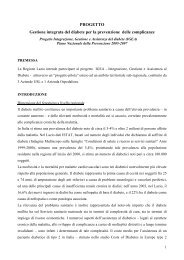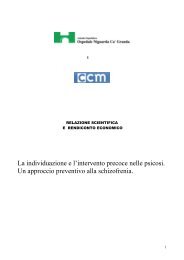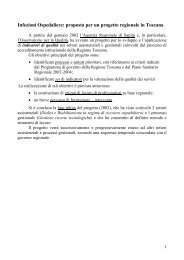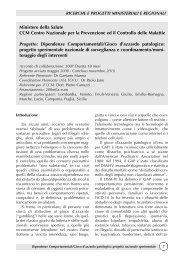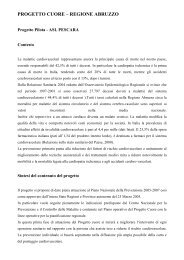Gaining health : analysis of policy development in European ...
Gaining health : analysis of policy development in European ...
Gaining health : analysis of policy development in European ...
Create successful ePaper yourself
Turn your PDF publications into a flip-book with our unique Google optimized e-Paper software.
Chapter 4<br />
146<br />
able reasons, the M<strong>in</strong>istry <strong>of</strong> Health pays more attention<br />
to the key elements <strong>of</strong> the reform (co-payments,<br />
restructur<strong>in</strong>g <strong>of</strong> the care system, new systems <strong>of</strong><br />
<strong>in</strong>surance, etc.) and less on long-term issues <strong>of</strong> <strong>policy</strong><br />
<strong>development</strong> to tackle NCD.<br />
• The complicated economic situation <strong>of</strong> the country restricts<br />
possibilities for public fund<strong>in</strong>g. This rather difficult<br />
f<strong>in</strong>ancial situation requires <strong>in</strong>novative ways <strong>of</strong> th<strong>in</strong>k<strong>in</strong>g <strong>in</strong><br />
us<strong>in</strong>g the assets <strong>of</strong> the country and creat<strong>in</strong>g a closer l<strong>in</strong>k<br />
between <strong>health</strong> and <strong>development</strong>.<br />
• In the medium term, the EU structural funds <strong>of</strong>fer a<br />
unique opportunity for <strong>in</strong>vestment <strong>in</strong> build<strong>in</strong>g new capacities<br />
for NCD prevention and <strong>health</strong> promotion.<br />
• Inequalities <strong>in</strong> <strong>health</strong> are much larger than the EU average<br />
and are still <strong>in</strong>creas<strong>in</strong>g. The present situation challenges<br />
<strong>policy</strong> <strong>development</strong> to use new techniques for an<br />
efficient way <strong>of</strong> tackl<strong>in</strong>g social and economic determ<strong>in</strong>ants<br />
<strong>of</strong> <strong>health</strong> <strong>in</strong> Hungary.<br />
• Globalization greatly affects the Hungarian economy and<br />
society, <strong>in</strong>clud<strong>in</strong>g the <strong>health</strong> sector. It is a huge challenge<br />
for capacity build<strong>in</strong>g, learn<strong>in</strong>g processes and <strong>in</strong>novative<br />
th<strong>in</strong>k<strong>in</strong>g to use the opportunities and to limit the<br />
potential for harm <strong>of</strong> ongo<strong>in</strong>g change. This stresses the<br />
responsibility <strong>of</strong> <strong>policy</strong> <strong>development</strong> to tackle NCD.<br />
5.2. Indications <strong>of</strong> the value system underly<strong>in</strong>g <strong>policy</strong><br />
<strong>development</strong><br />
The NPHP and other key <strong>policy</strong> documents def<strong>in</strong>e the<br />
values and visions for <strong>health</strong> <strong>policy</strong> accord<strong>in</strong>g to the major<br />
programmes <strong>of</strong> WHO and the EU. These values are based<br />
on a broad national consensus and clearly l<strong>in</strong>ked to those<br />
<strong>of</strong> the WHO Health for All <strong>policy</strong>. They are, however,<br />
sometimes poorly translated <strong>in</strong>to action. Thus, although<br />
the Constitution guarantees <strong>health</strong> as a human right, the<br />
prerequisites for <strong>health</strong> are largely miss<strong>in</strong>g <strong>in</strong> society and<br />
<strong>in</strong>equalities are still <strong>in</strong>creas<strong>in</strong>g.<br />
5.3. From awareness build<strong>in</strong>g to <strong>policy</strong> action<br />
The Hungarian Parliament adopted a resolution on the<br />
NPHP <strong>in</strong> 2003. Us<strong>in</strong>g exist<strong>in</strong>g experience and work<strong>in</strong>g<br />
papers from the previous programme, the NPHP was<br />
developed <strong>in</strong> only six months. A small number <strong>of</strong> <strong>in</strong>ternational<br />
experts <strong>in</strong> <strong>health</strong> promotion and disease prevention<br />
played an <strong>in</strong>fluential role <strong>in</strong> guid<strong>in</strong>g the <strong>policy</strong> <strong>development</strong><br />
process. The role <strong>of</strong> prime movers has been decisive <strong>in</strong> the<br />
case <strong>of</strong> Hungary for any important policies to tackle NCD.<br />
The NPHP <strong>in</strong>cludes 19 priority areas based more on a sophisticated<br />
balance among the different <strong>in</strong>terest groups than<br />
on clear priority-sett<strong>in</strong>g mechanisms, comb<strong>in</strong><strong>in</strong>g different<br />
approaches focus<strong>in</strong>g on risk factors, sett<strong>in</strong>gs and lifestyle.<br />
The NPHP lacked a <strong>policy</strong> <strong>analysis</strong> <strong>of</strong> the experience <strong>of</strong><br />
former Hungarian strategies and <strong>in</strong>formation on exist<strong>in</strong>g<br />
capacities was only partly available. Nevertheless, appropriate<br />
basic <strong>in</strong>formation for shap<strong>in</strong>g the <strong>policy</strong> document was<br />
available, <strong>in</strong>clud<strong>in</strong>g data on morbidity, mortality, lifestyles,<br />
risk factors, and geographical and social <strong>in</strong>equalities <strong>in</strong><br />
<strong>health</strong>. However, the text <strong>of</strong> the NPHP did not <strong>in</strong>clude any<br />
proposals for its implementation and the central managerial<br />
coord<strong>in</strong>at<strong>in</strong>g structure is still fluid and unclear.<br />
The status <strong>of</strong> and relationship between different strategies<br />
for the prevention <strong>of</strong> NCD are not clear or consistent. The<br />
various sub-policies are not always and explicitly <strong>in</strong>tegrated<br />
<strong>in</strong>to the overall NPHP framework, and one can discern that<br />
some sub-policies have been developed <strong>in</strong>dependently. The<br />
most important, clearly identified sub-policies are those<br />
on tobacco control, food and nutrition, alcohol control and<br />
physical activity. Recently, a National Cardiovascular Diseases<br />
Prevention Programme and a National Cancer Control<br />
Programme have been drawn up by the Government.<br />
Promot<strong>in</strong>g <strong>health</strong> and prevent<strong>in</strong>g disease <strong>in</strong> sett<strong>in</strong>gs are the<br />
success areas <strong>of</strong> the last decade. Three major strands are<br />
dom<strong>in</strong>ant <strong>in</strong> combat<strong>in</strong>g NCD: <strong>in</strong> cities and communities, at<br />
the workplace and <strong>in</strong> schools.<br />
Case studies: <strong>policy</strong> <strong>development</strong> <strong>in</strong> countries for tackl<strong>in</strong>g noncommunicable diseases




